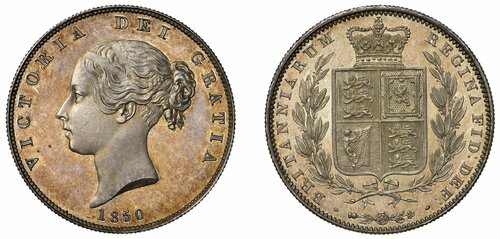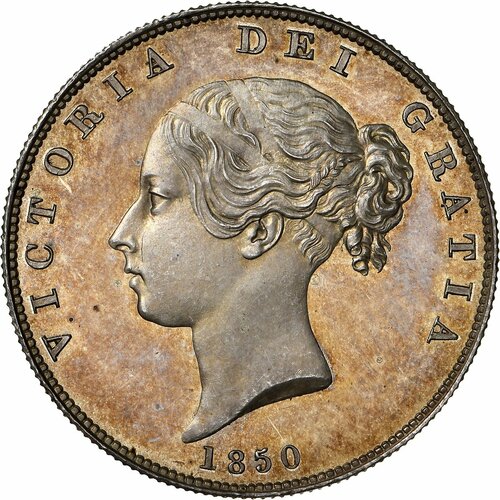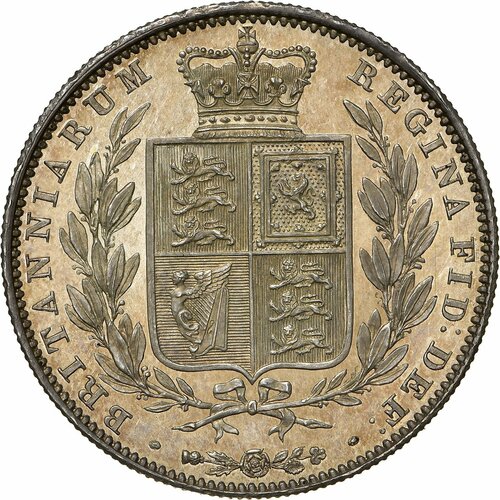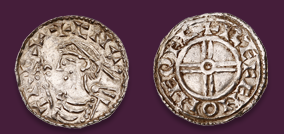Auction: 21005 - The Piccadilly List (Fixed Price, First Come First Served)
Lot: 31
BUY NOW: £39,000 | The Ultimate Halfcrown Rarity: The Elusive 1850 Proof and Coins of England 2019 Cover Coin | PF64 CAMEO | *Top Pop* | Victoria (1837-1901), "VIP" Proof Halfcrown, 1850, type A4, young head left, two fillets binding hair, plain truncation, finely toothed border both sides, rev. crowned quartered shield of arms, eight strings to Irish harp, all within laurel wreath, emblems below, edge milled, 6h (Montagu [1890] 1629; Murdoch III, 572[a]; Renotiere -; Adams 684; Davies 575; ESC 685 [R4]; Spink 3888 ~ 2019 Cover Coin), a sensational and exquisite Victorian rarity tantamount to a 'VIP' striking for exclusivity alone and far rarer than the standard references indicate herein presented in near flawless preservation, superbly choice, FDC, in NGC holder, graded PF64 CAMEO (Cert. #2822098-002)
This excessively rare Proof presents a simple conundrum for its raison d'etre. No authority has yet come forward with a firm explanation for its existence, and few have ever been privileged enough to possess one. It is however clear from contemporary events that it was the product of unique circumstances in the long and illustrious history of British currency. The last example to be offered at a major auction house came with the sale of the Colin Adams collection through our rooms in December 2005. From extensive research, only these two examples can be traced in commerce, one passing through the Murdoch collection, the other handled by Mr Brice before coming into the possession of Montagu (Spink Numismatic Circular, June 1895, no. 24584 - F.D.C. - £4.10.0). Since then, appetite and with it long overdue global interest has piqued for the Victorian series - a period which came to challenge four centuries of established numismatic tradition and the diverse experimentation with Britain's first decimal coins - a move that would ironically spell the end of the noble Halfcrown.
On the 27 April 1847, Sir John Bowring advocated the motion to introduce a decimalised currency system in the House of Commons. Sir Charles Wood, 1st Viscount Halifax, the Chancellor of the Exchequer remainder hesitant to the concept, reminding the House that 'there was hardly anything with respect to which the minds of people, or perhaps their prejudices, were more difficult to change, than the coinage of their country'. In a compromise, he acknowledged the benefits of two-shilling pieces, conforming both to the pre-existing system, and the proposed decimalised unit of account. The flan was therefore full proof and no economic harm could result whether the coin was a success or a failure. Several names were suggested for William Wyon's beautiful series of subsequent trials, from a Decime to a Decade and even 'a Victorine'. However it was felt that the sobriquet 'Florin' was appropriate for the coin entering circulation in 1849, given its obvious similarity to the contemporary Dutch and Austrian specie.
Rarely do trial coins go off without animadversion, and the new Florin was no exception. Critics were quick to point out the glaring omission of the conventional titles DEI GRATIA ['By the Grace of God'] in the legends alongside its distinctly continental name! Despite an official confirmation of Royal assent for the design, and indeed precedent for the omission in 17th and 18th Century Copper coinings, conservatives were quick to point the finger of blame. John Bull writing:
'A straw thrown up into the air shows which way the wind blows, so does the new coinage recently issued from the Royal Mint. All coins hitherto circulated in this country have borne the stamp of principles on which the Sovereign of these realms wears the Crown and wields the Sceptre. The Royal effigy has ever been surrounded by an inscription setting forth the name of the Kingdom "Britanniarum Regina", the title on which the kingdom is held: 'Dei Gratia', and the religious character of the Kingly office "Fidei Defensatrix". Why, then are all these particulars omitted on the 'florin' pieces just put into circulation? Why have we a bare REGINA substituted for the proper constitutional title of our Sovereign? Is it not enough that we should have a novel kind of money with an outlandish name (we think a 'Victoria' more appropriate) inflicted upon us; must we have the foreign notions of Regal authority foisted upon us at the same time? Our beloved Queen is the Queen, not of the Britishers, but of Britain; she is Queen, not by will of the people, but by the Grace of God; she is not without a public profession of faith, in her official character, but is, by virtue of her Royal office, the Defender of the Faith - a definite faith, a faith to wit of the United Church of England and Ireland. Why then is all reference to this omitted? Is it because we have a Papist presiding over the Royal Mint?"
A second commentator went further still: "a new silver coin....issued under the auspices of a Ministry notorious for their disregard of Christian obligation and by a Romanist Master of the Mint [Richard Lalor Shiel]. The circumstance is naturally viewed with suspicion as a purposed design to exclude the recognition of Divine Grace, which every Sovereign, since the Reformation has gladly acknowledged. It has been asserted that the omission was at the suggestion of an exalted personage, but this is manifestly a scandalous libel, undeserving of refutation, and only serving to show the axioms of the party which now, unfortunately for England, has the predominance. Apart from the consideration of its graceless character, the Florin is useless as a coin, and disgraceful as a work of art. As a piece of money it will only serve to deceive the unwary as a substitute for a Half-crown, whilst its execution, filled as it is with scratchy ornaments, causes it to resemble rather a Birmingham pocket-piece than an English coin. Instead of the bold relief and beautiful simplicity which characterised the money of George III and George IV, it appears like a trashy medal of the smallest intrinsic value, and the most judicious course that could have been taken was to suppress its further issue." (Exeter and Plymouth Gazette, 27 October 1849).
The furore would result in Shiel being hauled to the House of Commons in February 1850 to confirm that a redesign of the coin was taking place to incorporate 'D: G:', paving the way for the creation of the 'Gothic' Florin in 1852. The Era would summarise the affair: 'On Monday, the Master of the Mint cut a very contemptible figure respecting the omission of the words from the Florin and the cause of the withdrawal of that unique and loyal coin. It is quite certain he, a Roman Catholic Master of the Mint, could give no answer to the question of why the words 'Defender of the Faith' were omitted, nor did he avow the real cause why the said coin, so suspiciously struck, was withdrawn from circulation. The Protestants of England can however draw their own conclusions.' By April, the dispute had reached entertainment halls, with a report of Evadne at Sadler's Wells Theatre signed off by a critic with the following satirical jibe: 'The compliment was a happy one, and for Mr Shiel we shall say, that it is a pity that a man who could write so well, should have written so little and the author of such a brilliant genius should have sunk down into a mere 'Master of the Mint' wasting his midnight lamp on the unsuccessful design of the two-shilling-florin, instead of throwing off metal of more sterling stuff from the rich ore and mint of his brain.'
Sir James William Morrison, Deputy Master resigned later that month, ending a half-century or more of service at the Royal Mint. By August, a committee would advise 5 to 3 that Shiel should be unfrocked and the position of Master of the Mint be replaced by an officer under direction of the Treasury.' At the same time, further consideration was made about the convenience of revaluing the existing currency system based on the pre-existing specie, in particular the value of the Farthing, presently equated at 1/960 of a Pound. Were a simple retariffment made to 1/1000 of a Pound, the following break-down could occur: (Crown = 250 Farthings; Halfcrown = 125 Farthings; Shilling = 50 Farthings) and the adoption of a revised Sixpence known as a 'Half-Shilling' of 'Five New Pence'. The astute will immediately realise such a pattern was actually trialled at the Royal Mint in 1856.
From a top down reorganisation of Royal Mint's management to its expected rollout of Britain's first current decimal coin, 1850 would prove to be a watershed for British coinage, and the last year for the current Halfcrown for almost a quarter-century. As a result several obvious theories arise for this Proof's existence, ranging from the romantic to the historic:
End of an Issue
A contemporary collector realising the phasing out of the currency Halfcrown in favour of the Florin may well have requested a special striking to mark the occasion. Such news is lamented in broadsheets of the time: 'It appears that the last coinage of half-crowns was in 1850 and that no more will be coined.' (Berkshire Chronicle, 27 August 1853). The Royal Mint, by this time was well versed in special productions, with Wyon's famous 1839 and 1847 issues already in high demand, not to mention the 15th Anniversary of the Coronation issues being produced in 1853. The mystery would remain as to why so few were therefore struck which perhaps indicates a later striking date.
A Royal Birth
Certain Victorian proofs have been associated with important Royal events, such as a birth or foundation of a national monument. 1841 saw the birth of the future King Edward VII and the production of off-metal strikings of the Penny in silver. Similarly the 1864 Pattern Halfcrown has traditionally been connected with the opening of the Albert Memorial in Hyde Park. In 1850, Queen Victoria gave birth to Arthur, Duke of Connaught, her seventh child, providing a possible link with our offering. However beloved an arrival, no other immediate parallels can be found between 1841 and 1850 to associate with her other children, likely discounting this otherwise charming theory.
A Halfcrown Anniversary [?]
Astute numismatists will note the significance of the year 1850 to the Halfcrown, being the 400th year of its issue since first coined in the reign of Edward VI in 1551. Given the uptick in interest in numismatics in the 1840s from the publication of Roger Rudings groundbreaking work, to the formation of the Royal Numismatic Society and the wider artistic fascination in Gothic revival, awareness of this Anniversary is entirely plausible. However two counterpoints exist, why not issue in 1851? and why not include the Crown, Shilling and Sixpence which also made their first appearance at this time?
National Event [?]
The Victorian period is defined by the Industrial Revolution and the age of Great Exhibition, such as the most famous occasion in 1851. Perhaps the Royal Mint was experimenting with issues it would plan to strike at the event. As Earl Fitzwilliam had suggested to Prince Albert at a meeting in York ("The Exhibition of 1851: New Decimal Coinage", The Daily News, Tuesday 12 November 1850). A similar thread could be proposed for the 1862 and 1864 Patterns given their marriage with the 'Great London' and 'Royal Academy of Art' Expositions. However no such proofs are known for the actual year of the Great Exhibition, so this theory equally falls flat.
A Royal Mint Event [?]
An impromptu visit to the Mint by the Royal household or the marking of an appointment could equally account for the issue, the former having known precedents in the Hanoverian series, especially with the re-employment of coin dies. Similarly the department of Shiel and Morrison in 1850 may explain these as parting gifts.
Perhaps none of the above are responsible for its existence, or maybe it is a combination of all. Spink is however delighted to present this, the 2019 Coins of England Cover coin, in its full glory, with its enchanting mystique and excessive rarity as the unmissable purchase for the 'trophy hunting' connoisseur and Halfcrown addict!
This item is available for purchase at the published fixed price at www.spink.com. No Buyer's Premium or VAT is applicable. All offers will be processed within 2 working days, and successful purchases invoiced by email for payment within seven days.
Subject to 20% VAT on Buyer’s Premium. Not applicable to "Buy Now " offerings. For more information please view Terms and Conditions for Buyers.
Estimate
£39,000
Starting price
£39000









